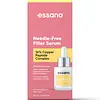What's inside
What's inside
 Key Ingredients
Key Ingredients

 Benefits
Benefits

 Concerns
Concerns

No concerns
 Ingredients Side-by-side
Ingredients Side-by-side

Water
Skin ConditioningGlycerin
HumectantButylene Glycol
HumectantPentylene Glycol
Skin ConditioningDimethyl Isosorbide
SolventBis(Tripeptide-1) Copper Acetate
Skin ConditioningAcetyl Hexapeptide-8
HumectantAcetyl Hexapeptide-51 Amide
Skin ConditioningSodium Hyaluronate
HumectantXanthan Gum
EmulsifyingPhenoxyethanol
PreservativeEthylhexylglycerin
Skin ConditioningDisodium Phosphate
BufferingSodium Phosphate
BufferingSodium Benzoate
MaskingCaprylyl Glycol
EmollientPotassium Sorbate
PreservativeCitric Acid
BufferingSodium Citrate
BufferingWater, Glycerin, Butylene Glycol, Pentylene Glycol, Dimethyl Isosorbide, Bis(Tripeptide-1) Copper Acetate, Acetyl Hexapeptide-8, Acetyl Hexapeptide-51 Amide, Sodium Hyaluronate, Xanthan Gum, Phenoxyethanol, Ethylhexylglycerin, Disodium Phosphate, Sodium Phosphate, Sodium Benzoate, Caprylyl Glycol, Potassium Sorbate, Citric Acid, Sodium Citrate
Ingredients Explained
These ingredients are found in both products.
Ingredients higher up in an ingredient list are typically present in a larger amount.
Water. It's the most common cosmetic ingredient of all. You'll usually see it at the top of ingredient lists, meaning that it makes up the largest part of the product.
So why is it so popular? Water most often acts as a solvent - this means that it helps dissolve other ingredients into the formulation.
You'll also recognize water as that liquid we all need to stay alive. If you see this, drink a glass of water. Stay hydrated!
Learn more about Water